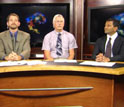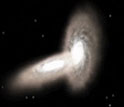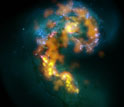News Release 11-212
ALMA Opens Its Eyes
Humanity’s most complex ground-based astronomy observatory opens for business

This image of a colliding pair of spiral galaxies displays a history of star making.
October 3, 2011
View a webcast with Kartik Sheth and Adam Leroy of NRAO and Brad Whitmore of STSI; video of the ALMA site in Chile; and a simulation of two colliding galaxies.
This material is available primarily for archival purposes. Telephone numbers or other contact information may be out of date; please see current contact information at media contacts.
Researchers presented details about an eagerly awaited new astronomical observatory during a live webcast last Thursday with the National Science Foundation and the National Radio Astronomy Observatory (NRAO).
Astronomers Kartik Sheth and Adam Leroy of the NRAO's North American ALMA Science Center, and Brad Whitmore of the Space Telescope Science Institute, discussed details of the first scientific observing cycle with the Atacama Large Millimeter/submillimeter Array or ALMA. They explained how ALMA will contribute to understanding the universe.
The researchers also discussed the first test image released by the ALMA collaboration. The image, a composite of views of the "Antennae Galaxy" was taken with several different types of telescopes, including test data from ALMA.
The ALMA image reveals hidden starbirth nestled inside otherwise obscuring dust clouds. The Antennae galaxies are the nearest and youngest example of a prototypical merging galaxy.
Additional discussions centered on a description of astronomers' strong response to the availability of observing time on ALMA, life at the ALMA site, and how ALMA will evolve over coming months from its current complement of 16 radio telescopes to its final array of 66.
The NRAO issued a full press release on ALMA's first scientific observing cycle, a period called Early Science, and released ALMA test images of the Antennae Galaxies.
-NSF-
-
View Video
Researchers explain how ALMA will contribute to our understanding of the universe.
Credit and Larger Version -
View Video
View a video of the ALMA site location in northern Chile.
Credit and Larger Version -
View Video
This is a video simulation of two galaxies colliding.
Credit and Larger Version -
ALMA's millimeter and submillimeter wave test views here are represented in orange and yellows.
Credit and Larger Version -
This image shows the relative elevations of some famous astronomical observatories.
Credit and Larger Version
Media Contacts
Lisa Van Pay, NSF, (703) 292-8796, email: lvanpay@nsf.gov
John Stoke, National Radio Astronomy Observatory, (434) 244-6896, email: jstoke@nrao.edu
Tania Burchell, National Radio Astronomy Observatory, (434) 244-6812, email: tburchel@nrao.edu
Program Contacts
Philip John Puxley, NSF, (703) 292-7835, email: ppuxley@nsf.gov
The U.S. National Science Foundation propels the nation forward by advancing fundamental research in all fields of science and engineering. NSF supports research and people by providing facilities, instruments and funding to support their ingenuity and sustain the U.S. as a global leader in research and innovation. With a fiscal year 2023 budget of $9.5 billion, NSF funds reach all 50 states through grants to nearly 2,000 colleges, universities and institutions. Each year, NSF receives more than 40,000 competitive proposals and makes about 11,000 new awards. Those awards include support for cooperative research with industry, Arctic and Antarctic research and operations, and U.S. participation in international scientific efforts.
Connect with us online
NSF website: nsf.gov
NSF News: nsf.gov/news
For News Media: nsf.gov/news/newsroom
Statistics: nsf.gov/statistics/
Awards database: nsf.gov/awardsearch/
Follow us on social
Twitter: twitter.com/NSF
Facebook: facebook.com/US.NSF
Instagram: instagram.com/nsfgov





